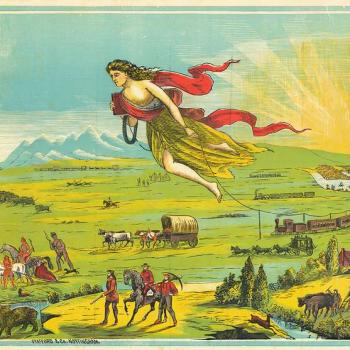It is clear that the current firestorm over same-sex marriage, though rhetorically tied to preserving a conservative concoction of ideal family values, is primarily about obsessive fears with deep roots in Western Christian history about men pleasing men and women pleasing women (coming out of Mark Jordan's work Invention of Sodomy; also present in Foucault's history of sexuality; somehow connected to Ted Haggard, too). The confusing history of the word sodomy, and its application by the church to describe a variety of behaviors, highlights the persistent difficulties posed by these sexual preferences, or "orientations" as we like to say today, within Christian communities, let alone outside of them.
Sex between men and sex between women can be about more than physical pleasures, or erotic transgressions, or sensual explosiveness; much to the chagrin of conservative moralists devoted to reproductive sex (the only sacred kind), it is often described in deeply religious terms and explicitly spiritual language. Compared to the days before Stonewall, when the pleasures of gay and lesbian sex rarely made their way into public culture, these communities now have a voice on the social stage and a presence in most media, including journals, videos, books, television, and websites, which allows them to offer alternative visions of homosexuality than those coming from the statehouse and the pew. This alternative vision, however, is far from uniform, providing a range of perspectives within a complicated, heterogeneous community, where many self-identify as Christian, Jew, or Muslim and see their sexual preferences and experiences as unproblematic to their religious commitments, incorporating rather than excluding God.
But many also speak of divine sex that does not lead to the Divine One in heaven dressed in robes and sitting on a glorious throne; instead, cruising The Castro in San Francisco, experimenting with leather while role-playing with a lover, or having a night of romantic passion as an integral dimension of monogamous lifelong love, can all arouse and inspire a spiritual dimension to sex that lives beyond but does not deny the physical body and has both real- and other-worldly religious value and meaning. While this sentiment about sexuality is promoted by gays and lesbians within the many monotheistic traditions who can reconcile the potential for spiritual transportation (and transformation) during sex with their commitment to One God, many others do not need the comforting presence of God above to understand the extraordinary experiences that can emerge when members of the same sex make love -- or inflict pain, for that matter -- down below.
Guy Baldwin, a writer and world-class expert on gay male leather culture and sadomasochistic rituals, for example, speaks of S/M as a form of "holy fire" and characterizes it as a spiritual experience. In one interview, Baldwin indicated that his longstanding involvement in these rituals and that the spiritual dimensions of S/M are what kept him at it for so long, emphasizing a mystical element at the core of what for him, and a good many others, is a sacred act infused with sexual eroticism. "When I am with a partner with whom I can achieve a nearly perfect synchronous dance, my ‘self' becomes stripped of all of its external trappings... What I am left with is an ecstatic contact with Self."
The specifics of his religious experience vary depending, he says, on whether or not he is on top and in control, in which case Baldwin keeps his wits about him and does not lose consciousness. But make no mistake, the entire ritual does have an other-worldly, spiritually liberating quality, whether Baldwin loses control of sensory processing or not: "the ecstatic, transformational event can occur for me on either end of the top-bottom, master-slave, sadist-masochist dynamic."
Pain and leather, power and submission, can all play a part in the sacred dance of S/M ritual, but connections between spiritual elevation and sexual intimacy can occur in less extreme, more mundane, bedroom settings of same-sex couples as well. Many Americans think all of this is preposterous and see any alternative form of sexuality as hedonistic and devoid of spirit, displaying only base carnality and salacious immorality.
Yet a persistent refrain from within homosexual communities is that, au contraire, this alternative path often brings them right smack into a sacred realm uncharted, but vigorously suppressed by so-called normal folks who only get it on with members of the opposite sex.
Robert H. Hopcke, a psychologist and Jungian scholar, is convinced that sexuality and spirituality can overlap seamlessly in the lives of gay men, understanding both in terms of universal archetypes deeply embedded in consciousness and through his personal experiences as a gay man. "In my adolescence and early adulthood there was absolutely no question to me that eroticism was a divine gift. The most important relationship I had in high school was with the Italian-American captain of the soccer team... My relationship with him was clearly erotic and yet sacred at the same time... Gay sexuality, gay eroticism, is as transformative as any transformative sacred event."




